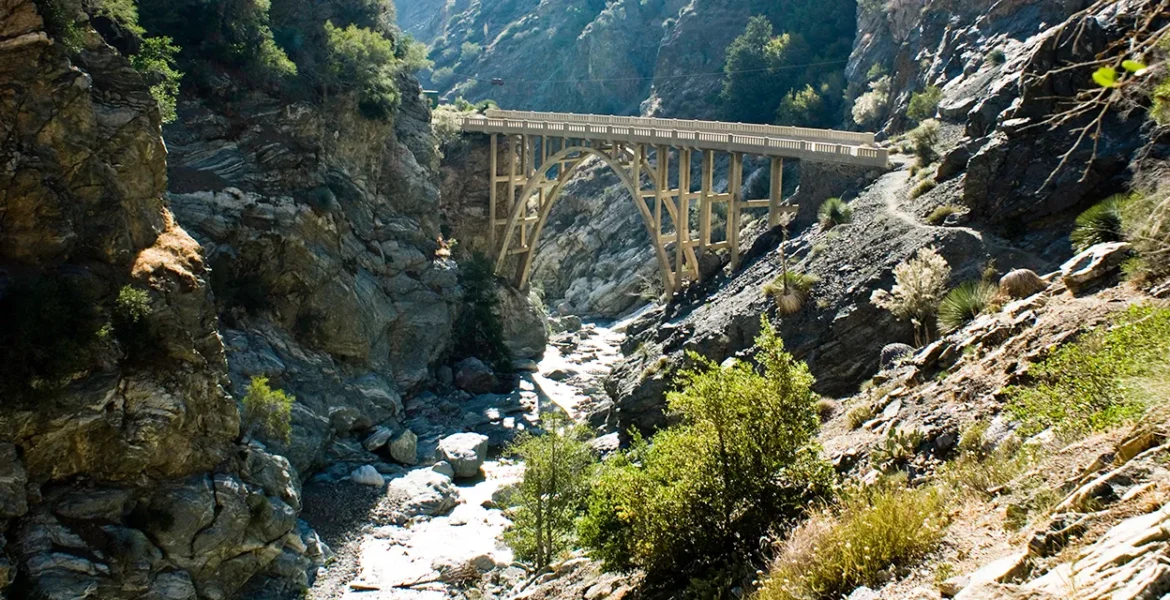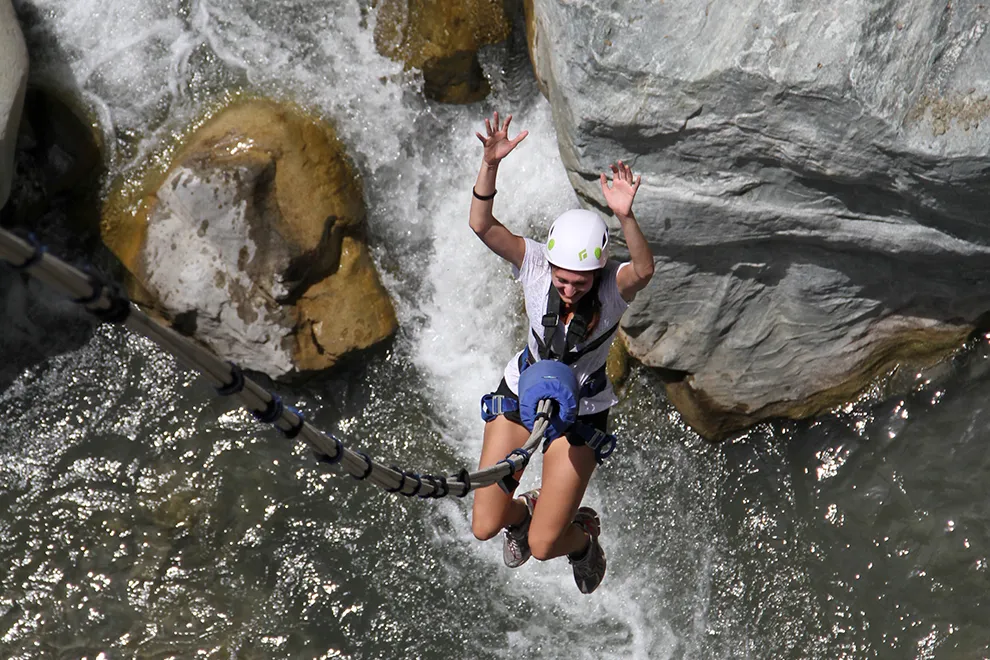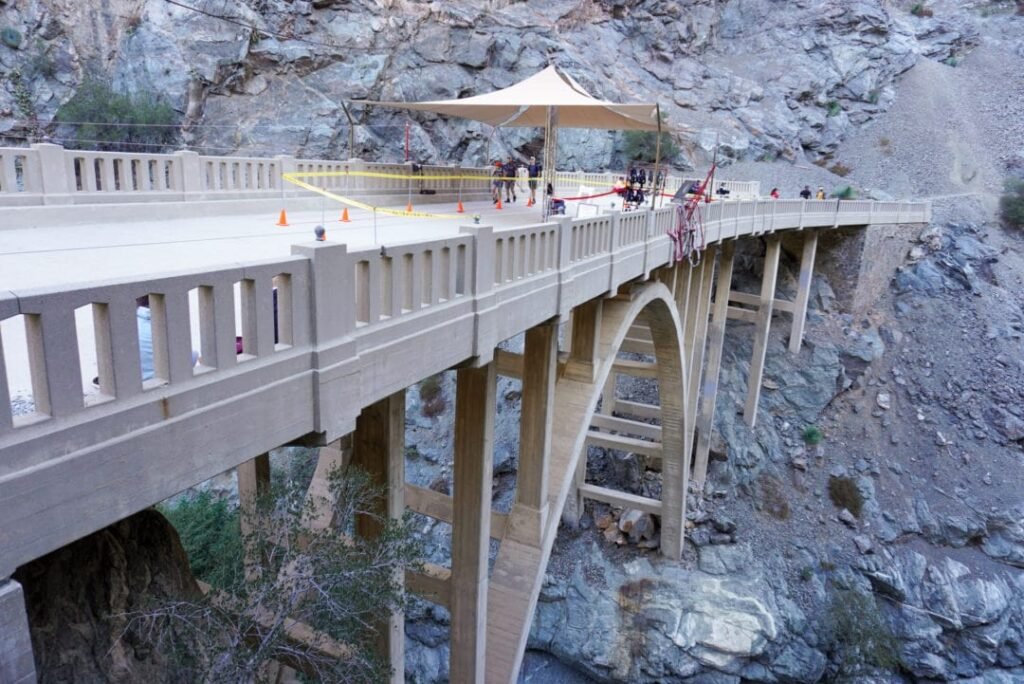
Bridge to Nowhere Hike: A Complete Guide for Adventurers
Introduction
The “Bridge to Nowhere hike” is one of Southern California’s most unique and thrilling adventures. Hidden deep within the San Gabriel Mountains, this surreal bridge stands isolated over a canyon with no roads leading to it, offering hikers a taste of mystery and a glimpse into history. The bridge’s mystique and its unexpected location have captivated explorers for decades. With every step on its rugged path, hikers are greeted with stunning canyon views, crystal-clear river crossings, and a sense of solitude that is rare to find so close to the urban sprawl of Los Angeles. In this guide, we’ll take you through everything you need to know about this iconic hike—from its intriguing backstory to trail tips that will make your journey unforgettable.
1. What is the Bridge to Nowhere?
The Bridge to Nowhere is a concrete bridge located deep in the San Gabriel Mountains of Southern California. Built in 1936, the bridge was part of an ambitious highway project designed to connect the San Gabriel Valley to the town of Wrightwood. However, after a catastrophic flood in 1938 washed away much of the planned road, the bridge was left standing alone with no access road to connect it. As a result, the bridge has become a symbol of failed human ambition, yet it also serves as an awe-inspiring landmark for hikers and adventurers. Standing over a canyon with the East Fork of the San Gabriel River flowing below, the bridge offers breathtaking views, making it one of the most unique hiking destinations in the region. Today, the bridge is a favorite for hikers, history enthusiasts, and thrill-seekers alike.
2. The History Behind the Bridge
The history of the Bridge to Nowhere is one rooted in both ambition and nature’s power. In the late 1930s, plans were underway to construct a highway that would connect the San Gabriel Valley to the mountain town of Wrightwood. This road, which was supposed to provide a shortcut through the rugged San Gabriel Mountains, was considered a major project for its time. The bridge was built as part of this highway construction, meant to cross the San Gabriel River and connect the sections of the road.
However, in 1938, disaster struck. A massive flood swept through the region, demolishing much of the roadwork, but leaving the bridge standing alone in the canyon. Because there was no longer any road to link to the bridge, the project was abandoned. Over time, the Bridge to Nowhere earned its name, as it became a symbol of what might have been. Despite its isolation, the bridge has stood the test of time, becoming a beloved piece of local history and a striking testament to nature’s ability to thwart even the most ambitious human efforts.

3. Location and How to Get There
The Bridge to Nowhere is located in the San Gabriel Mountains, near the city of Azusa, California. The easiest way to get there is by driving from Los Angeles, which is about a 45-minute drive away. From Los Angeles, take the 210 Freeway and exit at Azusa Avenue. Continue north on Azusa Avenue and then follow the signs to the East Fork Road. The trailhead is located at Heaton Flat, a popular starting point for the hike.
There is a parking lot at the trailhead, but you’ll need an Adventure Pass for parking, which can be purchased at various locations or online. The lot tends to fill up quickly, so it’s a good idea to arrive early, especially on weekends. If you arrive after the parking lot is full, you may need to park on the side of the road, but this can add additional time to your hike. Once you’ve parked, the trail begins at Heaton Flat Campground, where you’ll follow the East Fork Trail for about 10 miles, eventually reaching the Bridge to Nowhere.
4. Trail Overview
- Distance: 10 miles round trip
- Time: 5-6 hours
- Elevation Gain: 900 feet
- Trail Type: Out and back
The Bridge to Nowhere hike is approximately 10 miles round trip, making it a moderately challenging trek that requires a solid level of fitness. The trail features a 900-foot elevation gain, which means you’ll be walking uphill for parts of the journey, but the gradual incline makes it manageable for most hikers. As you move along the path, you’ll encounter multiple river crossings and rocky terrain, which can make the hike even more adventurous.
The trail is generally well-marked, and hikers can expect to navigate over a variety of terrains, including rocky trails, riverbanks, and shaded wooded areas. The path takes you along the East Fork of the San Gabriel River, crossing the river several times as you work your way through the canyon. While some sections are more challenging, the final destination—standing at the base of the bridge with its stunning views of the canyon—is well worth the effort.
5. Best Time to Hike
The best times to hike to the Bridge to Nowhere are spring and fall, when the weather is more temperate and river levels are more manageable. During these seasons, the temperatures are mild, ranging from 60°F to 75°F (15°C to 24°C), making it an ideal time for hiking. Spring also brings wildflowers to the trail, while fall offers cooler weather and colorful foliage, adding extra beauty to the experience.
While summer is still a popular time for the hike, it can be much hotter, with temperatures often exceeding 90°F (32°C). This can make the hike more taxing, especially since parts of the trail are exposed to the sun. If you decide to hike in the summer, it’s crucial to stay well-hydrated, wear sun protection, and start early in the morning to avoid the midday heat.
In winter, the trail becomes more difficult due to snowmelt, which can raise the water levels in the river, making river crossings more challenging. Additionally, mud can make the trail slippery and difficult to navigate. If you choose to hike in the winter, be prepared for these additional obstacles and check the trail conditions ahead of time to ensure a safe journey.
6. What to Bring
Before you head out on the Bridge to Nowhere hike, it’s important to pack properly for the journey. Here’s a list of essentials to bring:
- Sturdy hiking boots: The trail is rocky and uneven, so it’s essential to have good footwear with ankle support and slip-resistant soles.
- Plenty of water: The hike can take 5-6 hours, so bring at least 2 to 3 liters of water per person to stay hydrated.
- Snacks and lunch: Pack high-energy snacks such as trail mix, granola bars, and protein bars to keep your energy levels up. Consider packing a lunch if you want to enjoy a break by the river or at the bridge.
- Trekking poles: These are useful for maintaining balance during river crossings and walking over rocky sections.
- Waterproof bags: Protect your electronics and other valuables from getting wet, especially when crossing the river.
- Sun protection: Don’t forget sunscreen, a hat, and sunglasses to shield yourself from the sun.
- First aid kit: Always carry a small first aid kit to address minor injuries like cuts, scrapes, or blisters.
- Dry socks and towel: After crossing the river, it’s a good idea to change into dry socks. A towel can also help dry off your feet.

7. Trail Difficulty and Length
The Bridge to Nowhere hike is considered moderate to challenging due to its length and the multiple river crossings. While it’s only 10 miles round trip, the varying terrain can make it more strenuous than other hikes of similar length. The 900 feet of elevation gain is gradual but noticeable, especially on the way back when you’re tired from the long journey.
The river crossings are one of the most challenging aspects of the hike, as you’ll need to cross the San Gabriel River multiple times. Some of these crossings can be tricky, especially if the water is high or the rocks are slippery. If you’re not comfortable with river crossings, consider bringing trekking poles for added stability and take your time to choose your footing carefully.
That said, the trail is doable for most people with a moderate fitness level. Beginners should plan to take breaks and be prepared for a physically demanding trek. The reward at the end—the Bridge to Nowhere itself—is more than worth the effort, offering stunning views of the surrounding canyon.
8. Key Landmarks Along the Way
As you make your way to the Bridge to Nowhere, there are several key landmarks to look out for:
- Heaton Flat: The starting point of the hike. It’s a tranquil campground nestled near the river, where you can rest before heading out on the trail.
- River Crossings: The trail features multiple crossings of the San Gabriel River, where you’ll have to carefully navigate over rocks and possibly get your feet wet.
- Rock Formations and Hidden Caves: Along the way, you’ll pass fascinating rock formations, many of which have been carved by centuries of erosion. There are also hidden caves and overhangs perfect for a quick exploration or photo opportunity.
- Bridge to Nowhere: The final destination and the highlight of the hike. The bridge itself is a remarkable structure that offers an unobstructed view of the surrounding wilderness.
With these landmarks along the way, the hike offers plenty of opportunities to pause, take photos, and enjoy the beauty of nature before reaching your ultimate goal—the Bridge to Nowhere.
9. River Crossings and Safety Tips
One of the defining features of the Bridge to Nowhere hike is its numerous river crossings. Depending on the season, you may encounter anywhere from five to ten crossings along the San Gabriel River. In the spring and winter months, water levels tend to be higher, which can make traversing the river more challenging. During the summer, the crossings are typically shallower but still require caution.
To safely navigate the river, wear sturdy, water-resistant hiking boots or shoes with good grip. Trekking poles are highly recommended for balance, especially when stepping over slick rocks. Waterproof bags are essential to protect your belongings from accidental dips. Take your time when crossing; rushing increases the risk of slipping. In some sections, ropes are installed to aid with stability—use them if you need support.
Always assess the water flow before crossing. If the current looks too strong, wait for it to calm or consider turning back. Safety should always be your top priority.
10. Wildlife and Nature
The San Gabriel Mountains are teeming with wildlife, adding an element of natural wonder to your hike. You might spot deer grazing along the riverbanks or hawks soaring overhead. Birdwatchers can enjoy glimpses of species like the California quail, red-tailed hawk, and Western scrub-jay.
However, be mindful of less-friendly wildlife, such as rattlesnakes, which are known to sunbathe on rocks along the trail. Stay alert and avoid stepping into tall grass or shaded rock piles. If you encounter a snake, keep your distance and give it space to move away. Additionally, you might see bobcats or mountain lions, though sightings are rare. If you do, remain calm, make yourself appear larger, and slowly back away without turning your back.
The flora along the trail is equally stunning, especially in spring when wildflowers bloom in vibrant colors. You’ll see sycamore and willow trees lining the river, providing much-needed shade during hot days. The natural beauty of the hike is a photographer’s dream, offering countless opportunities for breathtaking shots.
11. Bungee Jumping at the Bridge
For thrill-seekers, the Bridge to Nowhere offers a unique adventure—bungee jumping. Operated by Bungee America, it’s the only legal bungee jump site in California. Participants can leap off the 120-foot-high bridge, experiencing the ultimate adrenaline rush amidst breathtaking canyon views. Bungee America provides all safety equipment and a detailed safety briefing before each jump. Reservations are required, and you can book online through their website.
If you’re not jumping, it’s still a spectacle to watch. Hikers often pause at the bridge to observe jumpers defy gravity and plummet into the canyon before bouncing back up. It’s a thrilling addition to the hike, even as a spectator.
12. Photography Tips
The Bridge to Nowhere hike is a photographer’s paradise. From the misty river crossings to the isolated grandeur of the bridge itself, there are countless moments worth capturing. For the best shots, consider bringing a waterproof camera or a protective case, as river crossings can be unpredictable. Early morning light casts a beautiful glow over the canyon, while late afternoon provides dramatic shadows that highlight the rugged landscape.
Drone photography is permitted but regulated, so ensure you follow local guidelines to avoid fines. Wide-angle lenses work great for capturing the vastness of the canyon, while telephoto lenses help get close-ups of wildlife. Don’t forget to pause and soak in the views—the best photos often come when you least expect them.
13. Rules and Regulations
To maintain the trail’s beauty and safety, hikers are required to follow specific regulations:
- Adventure Pass is required for parking at the trailhead.
- Pack out all trash—leave no trace.
- Stay on the trail to protect surrounding flora.
- No campfires are allowed due to fire hazards.
- Dogs are permitted but must be leashed.
- No motorized vehicles on the trail.
Failure to comply with these rules may result in fines or removal from the area. Following these simple guidelines helps preserve the trail for future adventurers.
14. Camping and Nearby Attractions
While camping is not allowed directly at the bridge, there are nearby spots where you can set up camp. Heaton Flat Campground at the trailhead is the most convenient option, offering basic amenities like fire pits and picnic tables. Further up the road, Crystal Lake Recreation Area provides more developed camping facilities and stunning lake views.
Nearby attractions include the East Fork of the San Gabriel River for fishing and Glendora Mountain Road for scenic drives. If you want to extend your adventure, consider exploring Mount Baldy or Angeles National Forest, both offering incredible trails and breathtaking vistas.
15. Final Thoughts and Recommendations
The Bridge to Nowhere hike is a journey back in time, offering both historical intrigue and natural beauty. Its unique location, challenging terrain, and stunning scenery make it a must-do for any adventurer in Southern California. Whether you’re there for the hike, the history, or the thrill of bungee jumping, the experience is one you won’t forget. Come prepared, respect the land, and you’ll find yourself enchanted by the hidden beauty of this mysterious bridge.

Leave a Reply